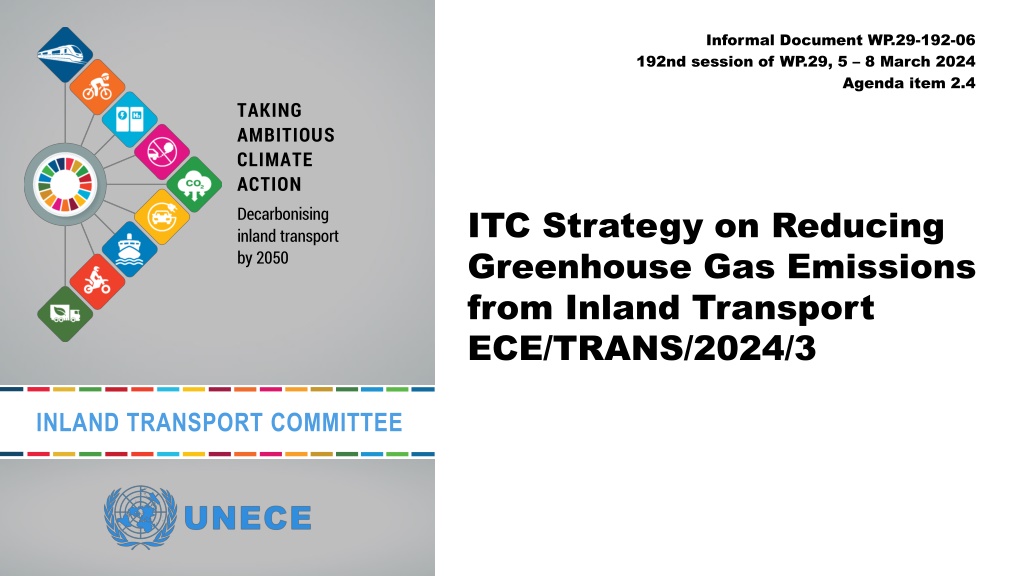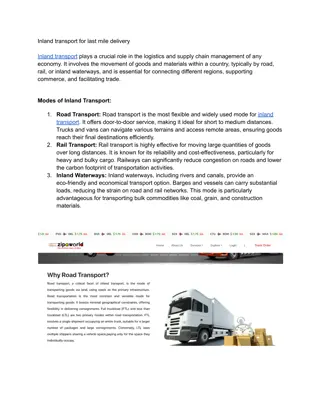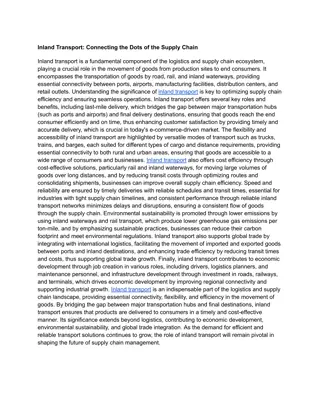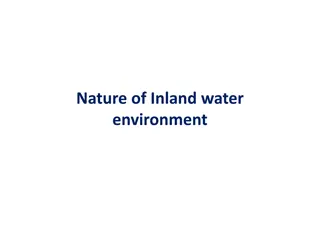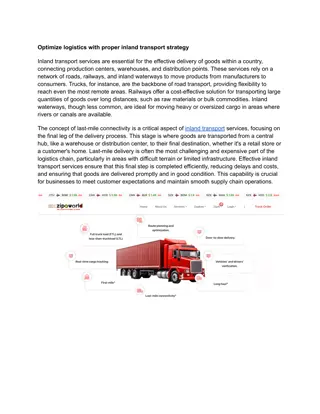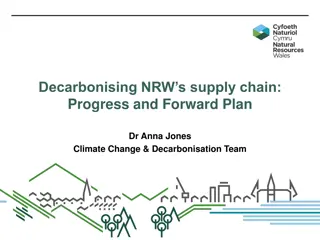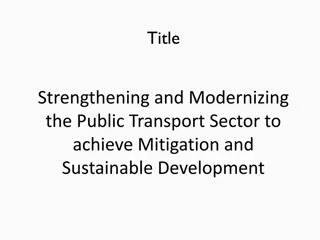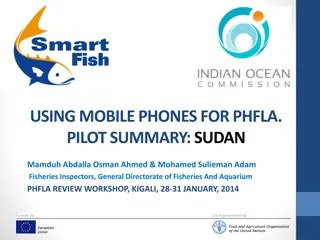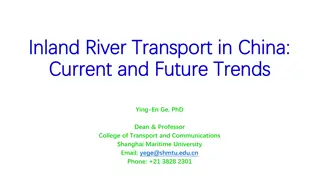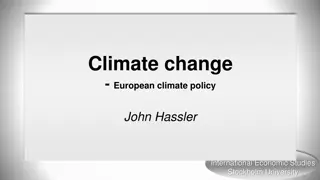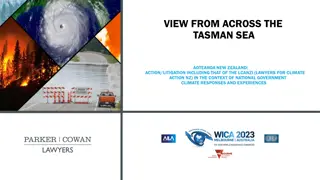Climate Action Strategy for Decarbonising Inland Transport by 2050
The Inland Transport Committee (ITC) has adopted a strategy to reduce greenhouse gas emissions from inland transport, aligning with the goal of achieving net-zero emissions by 2050. This strategy includes a focus on reducing GHG emissions, setting strategic objectives, implementing climate actions, and mobilizing resources. The ITC aims to support member states in decarbonizing inland transport through regulatory support, policy dialogue, and partnerships with stakeholders.
Download Presentation

Please find below an Image/Link to download the presentation.
The content on the website is provided AS IS for your information and personal use only. It may not be sold, licensed, or shared on other websites without obtaining consent from the author. Download presentation by click this link. If you encounter any issues during the download, it is possible that the publisher has removed the file from their server.
E N D
Presentation Transcript
Informal Document WP.29-192-06 192nd session of WP.29, 5 8 March 2024 Agenda item 2.4 TAKING AMBITIOUS CLIMATE ACTION Decarbonising inland transport by 2050 ITC Strategy on Reducing Greenhouse Gas Emissions from Inland Transport ECE/TRANS/2024/3 INLAND TRANSPORT COMMITTEE
Decision from ITC at its 86th session Decision from ITC at its 86th session ITC adopted the ITC strategy on reducing GHG emissions from inland transport Decision 4 2 ITC Bureau |November 2023 |Geneva
Climate strategy outline Climate strategy outline Inland transport and climate I. II. ITC vision and mission for climate action III. Strategic objectives IV. ITC-administered instruments to assist in mitigating climate change V. Initial ITC Climate Action Plan with milestones ITC to help deliver on climate goals and priorities VI. Resource mobilization for the delivery of this Strategy VII.Partnerships VIII.Periodic review ITC Bureau |November 2023 |Geneva
I. Inland Transport and Climate I. Inland Transport and Climate Future Demand: Passenger demand set to rise by 79% by 2050 compared to 2019, while Freight demand will double (ITF, 2023). Transport global GHG emissions trends 1990-2019 Back on past trend following COVID dip Meeting the goal of the Paris Agreement to UNFCCC: Need to limit temperature rise to 1.5 C. This will require GHG emissions to peak before 2025 and reduce by 43% by 2030 (6th IPCC Report, 2022). UN s stance: "Decarbonize all means of transport to achieve net-zero emissions by 2050." - UN Secretary-General (Beijing, 14 to 16 October 2021). Strategic Overview: Urgent action to support inland transport. Builds upon prior strategies by IMO, ICAO, ITC strategy until 2030(ECE/TRANS/288/Add.2) and Committee s revised Terms of Reference endorsed by ECOSOC (E/RES72022/2). Source: 6th IPCC report 2022, Climate Change 2022 - Mitigation of Climate Change , Sixth Assessment Report of the Intergovernmental Panel on Climate Change, Working Group III. ITC Bureau |November 2023 |Geneva 4
II. ITC Vision & Mission for Climate Action II. ITC Vision & Mission for Climate Action Vision The Inland Transport Committee and its subsidiary bodies take urgent action to assist its member States and Contracting Parties to United Nations legal instruments under its purview in achieving the aspirational goal of net zero GHG emissions from inland transport by 2050. Mission ITC s mission is to contribute to decarbonization of inland transport by its member States and Contracting Parties to United Nations legal instruments under ITC s purview through enhanced regulatory support, intergovernmental policy dialogue, and increased coordination and partnership among all relevant stakeholders. In doing so, the ITC draws from a broad decarbonization framework that draws on avoid-shift-improve measures which Member States may implement in any of or across the following areas: a) Avoid unnecessary vehicle kilometres through compact development, increasing accessibility to services, and reducing the need to travel as much as we do today b) Shift to low carbon, sustainable transport modes and/or operations; and c) Improve vehicles, infrastructure and operations. ITC Bureau |November 2023 |Geneva 5
III A. Strategic objectives III A. Strategic objectives for the ITC and its subsidiary bodies 1. Increased Inter & Intra-regional Governance Strengthen & elaborate inland transport regulatory framework. 2. Enhanced and more coordinated climate actions by and among ITC Subsidiary Bodies ITC provides enhanced guidance to their members on climate change abatement. 3. Increased intergovernmental Support for Climate Changemitigation and adaptation a) Foster regular policy dialogue for cooperation among member States and contracting parties to the United Nations inland transport legal instruments; b) Monitor progress on decarbonization of inland transport globally; c) Provide technical assistance advisory services, including awareness-raising, technical support, workshops, training and projects in support of climate change abatement; d) Provide analytical support. 6 ITC Bureau |November 2023 |Geneva
III B. Strategic objectives for the implementation III B. Strategic objectives for the implementation of the strategy by inland transport sector of the strategy by inland transport sector (a) Develop and enhance policies, legislation and measures Assess the feasibility and potential benefits to develop inland transport decarbonization action plans to the ITC & align, if applicable, with UNFCC NDCs & LTS Fully implement UN inland transport legal instruments Deploy carbon-neutral technologies & harmonize standardsacross border Facilitate modal shifts from road to rail/inland waterways & multimodalmobility Promote public transport and shared mobility options Ease the adoption of zero to low-carbon modes of transport Promote data collection on active mobility and Encouraging the use of globally harmonized indicators to monitor progress of inland transport decarbonization (b) Foster the efficient use of energy (c) Promote research and development in cooperation with academia and non-governmental bodies (d) Support circular economy related practices ITC Bureau |November 2023 |Geneva
III C. Horizontal objectives III C. Horizontal objectives Key role of the ITC: Through its unique intergovernmental framework, ITC provides comprehensive support to its members and contracting parties to the UN legal instruments in ensuring actions aimed at decreasing GHG emissions: a) Prioritizing Transport Affordability, Safety & Security b) Avoiding Negative Environmental and Health Externalities c) Fostering Inclusive Transport d) Making Transport Infrastructure and Operationsresilient to climate change. Source: UNECE Implementation of SDGs: a) Reduced traffic crashes, impact on air pollution and climate (SDGs 3 & 13) b) Improved urban mobility (SDG 3) c) Industry innovation & efficient infrastructure (SDG 9) d) Affordable and clean energy (SDG 7) e) Multi-stakeholder partnerships for 2030 Agenda (SDG 17) ITC Bureau |November 2023 |Geneva 8
IV. ITC IV. ITC- -administered instruments to administered instruments to assist in mitigating climate change assist in mitigating climate change Under ITC purview: 60 UN inland transport legal instruments, 49 in force; 152 UN Member States are parties to at least one legal instrument, increased accessions from outside ECE region Key areas in the avoid-shift-improve framework: AVOID: Develop tools and resource materials on increasing urban mobility efficiency (toolkit, publications, guidelines); promote transport-oriented urban development. SHIFT: UN inland transport infrastructure agreements support shift to low carbon, sustainable transport modes and operations: AGC, AGN for inland waterways and rail; AGTC for multimodal transport. Road traffic, transport of dangerous goods and vehicle conventions ensure road safety in decarbonization policies. IMPROVE: The globally-harmonized UN Vehicle Regulations improve vehicles and their operations; infrastructure agreements under the ITC purview improve inland transport infrastructure. Their climate change mitigation relevance could be enhanced with additional parameters on the availability (e.g., EV charging infrastructure, hydrogen refilling stations). 9 ITC Bureau |November 2023 |Geneva
IV. ITC IV. ITC- -administered administered in assist in mitigating c assist in mitigating climate WAY AHEAD IN CLIMATE CHANGE MITIGATION instruments struments to limate Change Change to ITC subsidiary bodies should Request contracting parties to apply climate considerations for amendments to the legal instruments. For example by: Legal instruments can be updated by WPs By adding clauses and/or Protocols. Develop additional legal instruments for the inland transport sector s decarbonization. Accelerated accessions beyond the ECE region - including a standing agenda item for subjective climate impact assessment of WPs decisions. - Each WP is fit for remote/hybrid decision taking Open legal instruments for all UN Member States' accession/ratification for carrying further their contribution to climate change abatement. Support and implementation Provide capacity development and policy advice under ITC s framework. Develop analytical and technical guidance materials. 10 ITC Bureau |November 2023 |Geneva
V. Initial ITC Climate Action Plan with milestones V. Initial ITC Climate Action Plan with milestones ITC to help deliver on climate goals and priorities to help deliver on climate goals and priorities ITC Initial actions for ITC and its subsidiary bodies to drive the change towards achieving the vision, mission and strategic objectives for curbing GHG emissions from inland transport. It comprises actions for specific ITC bodies, including joint and coordinated action among them. Indicative target years for implementation of each action are provided, which ITC can adjust depending on progress achieved. The action plan should serve as a living document. ITC will adjust and/or include therein additional actions during the plan s biennial review based on proposals made by its subsidiary bodies while completed actions will no longer be reflected in it. Actions targeting feasibility assessments will be considered by ITC or its subsidiary bodies based on the results stemming from these assessments so that follow-up actions are either implemented or terminated. In this way, ITC will manage this action plan. ITC Bureau |November 2023 |Geneva
V. ITC Climate Action Plan with milestones V. ITC Climate Action Plan with milestones ITC to help deliver on climate goals and priorities help deliver on climate goals and priorities ITC to Similar topic already in GRPE list of emission topics ITC Bureau |November 2023 |Geneva
ToRs for WP.5 informal TF on e-mobility adopted, as introduced Nov 2023 WP.29
V. ITC Climate Action Plan with milestones V. ITC Climate Action Plan with milestones ITC to help deliver on climate goals and priorities help deliver on climate goals and priorities ITC to IWG on A-LCA ITC Bureau |November 2023 |Geneva
VI. Resource mobilization for the VI. Resource mobilization for the delivery of this Strategy delivery of this Strategy Regular budget resources provided by member States to the ECE Transport subprogramme will continue to fund staff to service and update the existing legal instruments under the ITC s purview and develop new ones. The Working Parties and the secretariat will schedule their activities to evenly distribute the workload according to the initial ITC Climate Action Plan as well as resources available. implementation action, in particular relevant research activities, could be accelerated through additional extrabudgetary resources to be raised, among others, from developed countries. ITC Bureau |November 2023 |Geneva
VII. Partnerships VII. Partnerships ITC: A CENTRAL PLATFORM FOR KEY STAKEHOLDER COLLABORATIONS Global partnerships: UN organizations (UNFCCC, UNEP, WHO, the PEP, WMO, ITU), inter-sectoral (ICAO, IMO). UNFCCC & ITC: information exchange, transport decarbonization, UN GHG guidance, align ITC & UNFCCC discussions. UN Secretariat: partnerships with DESA, UN regional commissions; ITC & ECE Committees collaboration (e.g., GHG reduction via UNECE Forum of Mayors) & energy experts (WP.5). Cooperation: ICAO & IMO. Partnerships: financial institutions (GEF, GCF, World Bank Group), regional organizations (EU, EAEU). ITC: collaboration with transport organizations (ITF, IRU, OTIF, UIC) & NGOs/civil societies. Collaborate: decarbonization initiatives (Breakthrough Agenda, Net Zero Coalition), transport & EV manufacturers, academic researchers for climate innovations. ITC Bureau |November 2023 |Geneva
VIII. Periodic review VIII. Periodic review Review Cycle Every 5 years (First in 2029) / Action plan reviewed biennally ITC's Responsibilities: Central coordination & defining review scope and terms of reference. Assess progress of strategic objectives and action plan & set new actions and targets. Source: UNECE Knowledge Update: Incorporate latest knowledge on the decarbonization of the inland transport sector (e.g., latest reports from Intergovernmental Panel on Climate Change. Monitoring & Reporting: Regular monitoringStrategy implementation by ITC's subsidiary bodies. Biennial action reports & annual initiatives at ITC Forum on Climate change. ITC Bureau |November 2023 |Geneva
TAKING AMBITIOUS CLIMATE ACTION Decarbonising inland transport by 2050 Thank you! INLAND TRANSPORT COMMITTEE
